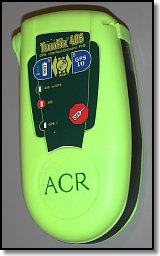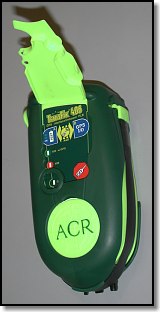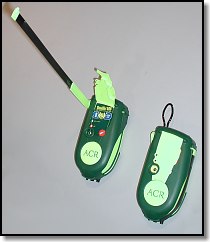

 |
 |
 The PLB wars are heating up. 2004 Outdoor Retailer Winter Market saw the introduction of ACR Electronics' next generation 406 MHz Personal Locator Beacon (PLB), the TerraFix / AquaFix / AeroFix 406 GPS. These three beacons are identical with the exception of holster color, for the moment it is simply a marketing ploy aiming them at the three primary markets, land, marine and aviation. The TerraFix is illustrated here and we'll use that to refer to the PLB in this artcile. The TerraFix is quite a departure from ACR's utilitarian-looking designs of the past with an ergonomic and stylish body and a host of new features and innovations. The following information was compiled from product brochures and discussion with ACR salespeople.
The PLB wars are heating up. 2004 Outdoor Retailer Winter Market saw the introduction of ACR Electronics' next generation 406 MHz Personal Locator Beacon (PLB), the TerraFix / AquaFix / AeroFix 406 GPS. These three beacons are identical with the exception of holster color, for the moment it is simply a marketing ploy aiming them at the three primary markets, land, marine and aviation. The TerraFix is illustrated here and we'll use that to refer to the PLB in this artcile. The TerraFix is quite a departure from ACR's utilitarian-looking designs of the past with an ergonomic and stylish body and a host of new features and innovations. The following information was compiled from product brochures and discussion with ACR salespeople.
Click here for more information on Personal Locator Beacons.
Available in two models, the base TerraFix 406 GPS I (Interface) model features external GPS hook-up similar to the existing ACR GyPSI PLB. Connect a handled GPS to the unit with a supplied infrared interface cable and the unit will transmit the GPS coordinates thus obtained. Manufacturer's Suggested Retail Price (MSRP) is $650, the same as their existing non-GPS enabled Personal 406 PLB. The new interface cable has a female serial connector at one end to mate with the existing standard programing cable that comes with most NMEA interface handheld GPS receivers and an integral LED to signal that data is being transmitted. On the AquaFix and AeroFix models the cable ends in two bare leads which should be soldered and waterproofed to the GPS' own cable, which will typically require you to obtain an extra one from the manufacturer.
The TerraFix 406 GPS I/O (Interface/Onboard) incorporates an integral GPS receiver while still retaining the external GPS hook-up (prototype photos included here). That provides a potentially useful additional capability over having only an integral GPS. At $750 MSRP, it is priced only $10 over the current GyPSY 406 which had only external GPS capability, Some simple math shows that also represents only a 17% upcharge over the external-GPS-only "I" model.
The "fiberglass reinforced polycarbonate blend" body is a greenish-yellow hue that they have dubbed "ACRtreuse." (Honest, I couldn't make that up.) It is attention getting, though much of the case will normally be covered up with a removable rubber "holster." The one shown was forest green for the outdoors market; aviation will get a black holster, the marine market a blue one.
 The holster provides a functional alternative to the pouch usually used to retain a PLB on a person. It is designed to mount horizontally or vertically on belts or webbing included on backpacks, life vests and the like. The holster has a flip-up hard lid that protects the face of the beacon's control panel. There is also what ACR calls a carabineer clip that is really a loop which may alternatively be used to attach the PLB to gear or to attach a lanyard to the beacon. It slips through a slot and jams into place.
The holster provides a functional alternative to the pouch usually used to retain a PLB on a person. It is designed to mount horizontally or vertically on belts or webbing included on backpacks, life vests and the like. The holster has a flip-up hard lid that protects the face of the beacon's control panel. There is also what ACR calls a carabineer clip that is really a loop which may alternatively be used to attach the PLB to gear or to attach a lanyard to the beacon. It slips through a slot and jams into place.
An optional ($23) two-compartment padded nylon pouch as comes with the GyPSI is available for someone who wants to carry it that way. It has room for the GPS needed for use with the "I" version and floats the unit upright in the water.
There is the usual self-test we have come to expect from a PLB, as well as battery test and for the unit with integral GPS, a functional test for GPS acquisition. In this mode the GPS is activated for up to 7 minutes and it seeks to acquire a GPS location, confirming that it has done so if successful. This is the only way to be sure the GPS receiver is actually functioning fully, something that has been missing from other PLBs with integral GPS to date. It also offers a unique capability in actual distress to check for GPS acquisition prior to deploying the beacon, a potentially very useful feature in some circumstances.
Another unique feature is that during the self-test and battery power test it will indicate if the unit has been operated for more than one hour cumulatively. With the ability to do more tests and especially the GPS acquisition test, also comes the ability to run the battery down more than the hour or so that would normally be expected over the five-year battery replacement interval for the battery. The batteries are rated for an 11-year service life.
Speaking of which, ACR has provided for the owner to replace the dual batteries themselves, if necessary or desired, but plans to have plenty of factory authorized battery replacement centers available for owners to take advantage of. These centers will have the training and equipment to pressure test and certify the PLB as fully operational, which after five years in the field is not a bad idea, in our opinion.
In addition, ACR claims their lithium batteries meet the requirements for non-HAZMAT (hazardous materials or dangerous goods) transportation. This can be a big saving, both in cost and paperwork, if shipping by air and would allow an owner to carry it on board an aircraft with no problems or hassles.
 Like the previous ACR PLBs, the flexible blade antenna wraps around the unit and is easy to deploy. It rotates 360 degrees for the optimum vertical position regardless of the position of the body.
Like the previous ACR PLBs, the flexible blade antenna wraps around the unit and is easy to deploy. It rotates 360 degrees for the optimum vertical position regardless of the position of the body.
The TerraFix is a Category 1, Class II PLB, meaning that it will float if dropped in the water and will function for at least 24 hours at -20°C (-4ºF).
Activation is by pressing down two surface mount tactile feedback buttons simultaneously for 5 seconds. This can be done with one hand. We won't know how well we like this until we get some time with a functional unit. The units at the show were still prototypes and this is an area still being refined.
Anticipated production weights are expected as follows:
Terrafix 406 GPS I - 11.75 oz. (333 g)
TerraFix 406 GPS I/O - 12.11 oz. (343 g)
Holster - 1.6 oz. (45.5 g)
That compares favorably with the McMurdo Fastfind Plus (integral GPS) that we recently weighed at 11.7 oz. (323 g). The holster adds a little weight, but precludes the need to use a pouch in many instances where one would be required for the Fastfind (3.5 oz (99 g) without its belt).
As for size, the TerraFix 406 measures overall 5.7 x 3.0 x 1.75 inches (14.5 x 7.6 x 4.4 cm). Add the holster and it's 6.2 x 3.15 x x 2 inches (15.7 x 8 x 5.1 cm). That compares to 6 x 3 x 2.1 inches (15.2 x 7.6 x 5.3 cm) for the Fastfind PLBs.
ACR has plans to eventually code the AquaFix and AeroFix PLBs as EPIRBs and ELTs, respectively. This would require the FCC to grant a waiver, so don't hold your breath. While many are in favor of this concept, coding them for their primary use, others oppose it, so it will likely be an uphill battle for ACR.
With these new TerraFix 406 GPS I and I/O PLBs, ACR appears to have upped the ante in the PLB wars with regards features and pricing and has become competitive with regards size and weight. We were told to expect deliveries to start in May, 2004, pending COSPAS-SARSAT and FCC approval. UPDATE 12/15/2004: ACR has begun shipping the TerraFix, AquaFix and AeroFix PLBs.
We will update this report when we have a production unit to evaluate.
|
| SELECT AND USE OUTDOORS AND SURVIVAL EQUIPMENT, SUPPLIES AND TECHNIQUES AT YOUR OWN RISK. Please review the full WARNING & DISCLAIMER about information on this site. |
Publisher and Editor: Doug Ritter
Email: Doug Ritter
URL:
http://www.equipped.org/terrafix_406gps_plb.htm
First Published: February 3, 2004
Revision: 04 March 1, 2005
![]()
Email to: [email protected]
|